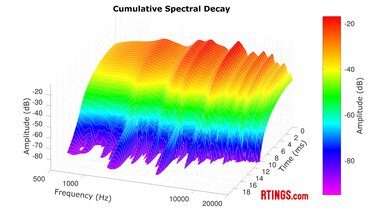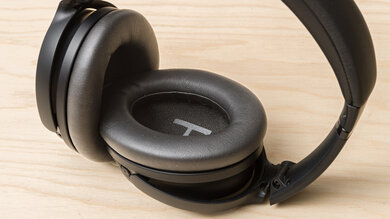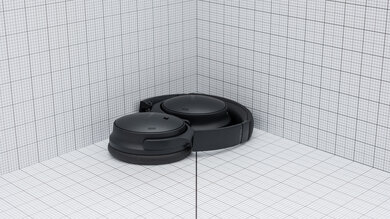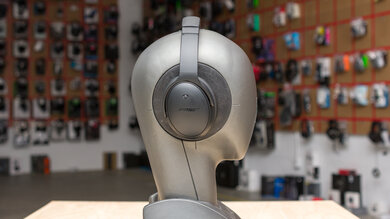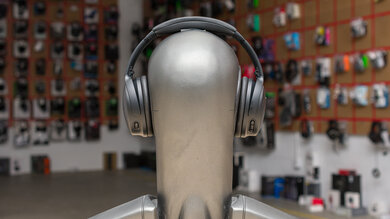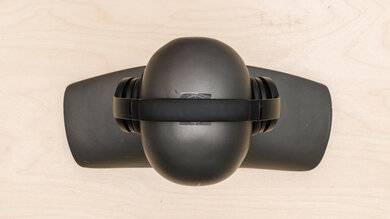The Bose QuietComfort Headphones Wireless are the next generation of the Bose QuietComfort 45/QC45 Wireless. These over-ears basically have the same design as their predecessor, so you can expect similarly lightweight and comfortable headphones with a top-notch noise cancelling (ANC) system. However, there have been a couple of adjustments, namely to their sound and the addition of an integrated mic on their analog cable.
Our Verdict
The Bose QuietComfort Headphones are good for sports. Over-ears aren't usually a good choice for workouts as they don't have the most stable design when moving and trap heat around your ears, but these aren't too bulky. They also lack an IP rating for water resistance, which is normal for over-ears. That said, these over-ears have a comfortable fit, and their wireless design ensures there's little that can snag the headphones and pull them off of your head.
- Outstanding noise isolation performance.
- Comfortable and well-built design.
- Can fall off your head with moderate movement.
The Bose QuietComfort Headphones are great for traveling. These comfortable and lightweight over-ears are equipped with an ANC system to block out a lot of ambient noise like rumbly bus engines around you. They also come with a sturdy hard case to protect them when you're on the go, and they fold down, too. They last over 26 hours continuously with their ANC on, which is great for long listening sessions.
- Graphic EQ and presets available via companion app.
- Outstanding noise isolation performance.
- Comfortable and well-built design.
Wired or wireless connectivity.
- Can fall off your head with moderate movement.
Limited control customization.
The Bose QuietComfort Headphones are good for office work. They have a comfortable fit, and thanks to their ANC system, they can easily block out chatty coworkers and the hum of AC units. With their ANC on, they last over 26 hours at a time, and you can use them wired in a pinch. They support multi-device pairing, too, so you can stay connected to your PC and smartphone simultaneously.
- Outstanding noise isolation performance.
Support multi-device pairing.
- Comfortable and well-built design.
Wired or wireless connectivity.
Decent built-in mic and an in-line mic.
- Can fall off your head with moderate movement.
Limited control customization.
No mic mute.
The Bose QuietComfort Wireless are Bluetooth headphones, so you can't wirelessly connect them to PlayStation or Xbox consoles. They also have high latency on PCs, causing your audio and visuals to fall out of sync.
The Bose QuietComfort Headphones are decent for gaming. Unlike their predecessor, their analog cable has an in-line mic, offering a good overall performance so your teammates will hear you clearly. Their bass-heavy sound can also help emphasize sound effects like footsteps without completely drowning out dialogue and instruments. They have a comfortable fit suitable for long gaming sessions, too.
- Comfortable and well-built design.
Decent built-in mic and an in-line mic.
Limited control customization.
No mic mute.
The Bose QuietComfort Headphones are decent for audio reproduction accuracy. Their frequency response generally follows their warm sound profile, with the exception of the treble range, which has some deviations. The L/R drivers are well-matched in terms of frequency, amplitude and phase, but some spikes in group delay in the bass-range can cause 808s and kicks to sound loose and messy. They exhibit very little harmonic distortion though, with no audible coloration and regular and elevated listening levels.
The Bose QuietComfort Headphones are amazing at attenuating external noise. The ANC system has the versatility to tamp down on ambient noise, ranging from the rumble of aircraft engines to the chatter of passengers on a train. They do leak a fair bit of noise though, so you'll need to be mindful of those around you if you like to blast your tunes in otherwise quiet places.
The microphone performance is mediocre. While the mic is able to capture your voice in a reasonably natural way, it rolls off a fair bit of the bass-range, making your voice sound thinner. It also does a poor job of isolating your voice from your surroundings, so background noise can frequently interfere with your intelligibility.
The Bose QuietComfort Headphones are very good at delivering audio consistently. Generally speaking, you can expect similar performance between different listening sessions, regardless of your facial features. However, glasses-wearers may notice a drop-off in the low-bass range as the arms of glasses can disrupt the headphones' seal.
Performance Usages
Changelog
-
Updated Jul 16, 2025:
This review has been updated to Test Bench 2.0, which adds the following tests: Stereo Mismatch, Group Delay, Cumulative Spectral Decay, PRTF, Harmonic Distortion, and Electrical Aspects. We've also added new performance usages and updated the text throughout the Sound tests.
- Updated Jul 10, 2025: We've converted this review to Test Bench 2.0, which updates our sound tests and adds performance usages. You can read more about this in our changelog.
-
Updated May 22, 2025:
We added the Twilight Blue variant to the 'Differences Between Variants' and Style sections of this review.
-
Updated Dec 05, 2024:
Several Sound tests have been updated following Test Bench 1.8. There have also been text changes made throughout the review, including to the usages and product comparisons to match these results.
Check Price
Differences Between Sizes And Variants
The Bose QuietComfort Headphones come in a handful of color variants: 'Triple Black,' 'White Smoke,' 'Moonstone Blue,' 'Twilight Blue,' and 'Cypress Green.' We tested the 'Triple Black' colorway; you can see our model's label here. Additionally, there's a limited edition colorway with Steve Lacy, which is a cream color with black trim and pink accents. You can also create custom color schemes through ColorWare's website for an added charge.
You can also find this model at Costco, but under a slightly different name, depending on your location: the Bose QuietComfort SC Noise Cancelling Headphones or Bose QC SC Headphones. This model comes with a soft case instead of a hard case, but we expect it to perform similarly to our unit otherwise.
If you encounter another variant of these headphones, please let us know in the comments, and we'll update our review.
Popular Headphones Comparisons
The Bose QuietComfort Headphones are the next iteration of the Bose QuietComfort 45/QC45 Wireless. Although both are nearly identical in design and have similarly outstanding levels of noise isolation with the same app, the QuietComfort Headphones include an audio cable with an in-line mic so you can take calls while wired. However, they don't block out as much background noise as the Sony WH-1000XM4 Wireless. Their continuous battery life isn't quite as long-lasting either, though 26+ hours will still be more than enough to get you through long days on the go.
If you're looking for more headphones, check out our recommendations for the best noise cancelling headphones, the best travel headphones, and the best Bose headphones.
The Sony WH-1000XM4 Wireless are more feature-packed than the Bose QuietComfort Headphones Wireless. The Sony have a virtual soundstage feature to help immerse you in your audio, have more robust customization features via their companion software, and support LDAC, which is Sony's codec for high-resolution audio. Their ANC also does an even better job of blocking background noise, and they have a longer continuous battery life. However, the Bose are more comfortable and better built with a different tuning you might prefer and an in-line mic for wired situations.
The Bose QuietComfort Headphones Wireless and the Sony WH-1000XM5 are headphones with excellent noise isolation. Both are equally stable, built well, and remarkably mitigate background noise from train engines to ambient conversation. The Bose are significantly more comfortable than the Sony, but they lack a dedicated virtual soundstage feature and leak more audio.
The Bose QuietComfort Headphones Wireless and the Apple AirPods Max are both high-end headphones. While both offer fantastic noise isolation performance, the Bose are much more comfortable and they have a longer battery life. Thanks to their companion app, they're also more customizable, and you can pair them with up to two devices at a time. However, the Apple headphones are better built and are more integrated into the Apple ecosystem, thanks to the H1 chip.
The Bose QuietComfort Ultra Headphones Wireless are a step up from the Bose QuietComfort Headphones Wireless, but many differences are small. Both pairs use the same app, but the QuietComfort Ultra add virtual surround sound. They also have a bit better build quality, slightly better ANC, and mic and noise handling performance. However, the standard QuietComfort Headphones don't trail behind far and include an analog cable with an in-line, in addition to the integrated mic, which adds flexibility.
Test Results

These headphones have a warm sound profile that accentuates bass frequencies. With that said, if you want a different tuning, their companion app includes a three-band EQ with presets.
Although we measured their sound performance using Bluetooth, you can expect the same performance via analog, so long as the headphones are powered on. You can see a graph comparing the frequency responses over Bluetooth and active as well as passive wired connections. However, when used passively, the headphones deliver a very different sound with anemic low bass, considerably more boom, a boosted mid-range, and harsh treble. Vocals and instruments take a hit, sounding hollow and veiled or piercing, depending on the pitch.
The Bose QuietComfort Headphones have very good frequency response consistency. Glasses-wearers might experience a drop-off in bass-range frequencies and other users will encounter some inconsistencies in the high-mid range. However, if you take the time to achieve a proper fit, seal, and positioning, you'll likely get consistent audio delivery each time you wear them.
These headphones have very good bass profile target compliance. While the low-end is over-emphasized throughout the range, adding extra boom and rumble in basslines to tracks like Satisfaction by Benny Benassi, for the most part, it's relatively smooth, so frequencies don't jump out within the playback.
The Bose QuietComfort Headphones' mid-range target compliance is outstanding. The response sticks to our curve well, so speech, vocals, and instruments sound present. However, the lower mid-range can sound a little cluttered, as it carries on the over-emphasized bass response, but this is very minor.
The headphones' treble target compliance is amazing. Their treble response is generally very smooth, with slight deviations across the range. Most of the mid-treble is bright and detailed, but a narrow peak adds artificial sharpness to harmonics like cymbals. Lastly, depending on your hearing sensitivity, the uppermost frequencies have a fairly airy quality that's not overwhelmingly brilliant-sounding.
The peaks and dips performance is good. The frequency response generally follows the warm sound profile closely in the bass- and mid-range. The largest deviations are in the treble range, which indicates that the response struggles to follow the sound profile in this range more than in other bands. A dip in the low treble hurts the detail and clarity of vocals and instruments, while a peak after adds harshness. The dips that bookend a prominent peak in the mid-treble make sibilants, like cymbals, either lispy or piercing, depending on the frequency range.
These headphones have a good stereo mismatch performance. These headphones have don't exhibit any major mismatches in amplitude, frequency or phase, which is indicative of tight tolerances between the L/R drivers.
The group delay performance is disappointing. Group delay crosses the audibility threshold in the low and mid-bass range, which results in an audibly loose bass response. While it's not very noticeable with genres like classical and folk, music with lots of 808s and sub-bass, like hip-hop of EDM tends to have a slightly muddy low end.
The Bose QuietComfort Headphones have a poor PRTF performance, but that's normal for closed-back headphones. They don't create much of a sense of immersion and audio seems like it's coming from inside your head rather than from speakers placed in front of you. On the upside, they do a good job of spreading the stereo field quite wide.
The harmonics distortion performance is great. While there are some spikes in the bass range, it's very difficult to hear distortion in this frequency band. At both regular and elevated listening levels, audio reproduction is clean and pure, without any audible coloration.
These Bluetooth headphones don't require an amp to drive them, even if connected via a wired connection.
These are the settings used to test the Bose QuietComfort Headphones. Our results are only valid when used in these settings.
These headphones look pretty similar to the Bose QuietComfort 45/QC45 Wireless. Their design is fairly non-descript and minimalist. The manufacturer's logo is found on the center of the ear cup. They come in a few different colors: 'Triple Black,' 'Smoke White,' 'Twilight Blue,' and 'Cypress Green.' There's also a limited edition model made in partnership with Steve Lacy. This model is cream with black trim and pink accents. If you want to truly trick out your headphones, ColorWare offers this model in custom color schemes at an added charge. The color options range from subdued to neon and iridescent. You can also add custom engraving.
Their physical controls are great. The layout is the same as their predecessor, with three buttons located on the right ear cup and the 'Action' button on the left cup. There are physical and audible clicks when pushing the buttons, and there are warning chimes to let you know when you've reached min and max volume. There are even voice prompts for switching connections, the ANC status, battery life, and pairing. There's no feedback when pressing the buttons; you'll only hear the voice prompt following your command.
On the left ear cup:
'Action' button:
- Single press: Cycles between 'Quiet' mode, which is ANC on, and 'Aware' mode, which is a talk-through mode that plays the sounds around you alongside your regular audio content, so that you can stay aware of your surroundings without having to pause your audio or take off your headphones.
- Press and hold: Access voice assistant.
On the right ear cup:
- '+' and '-': Raises and lowers the volume.
Center button:
- One press: Plays and pauses audio. Also answers and ends calls.
- Double press: Skips the track forward.
- Triple press: Skips the track backward.
- Press and hold: Declines a call.
Like most over-ears, they have a bulky design. However, you can fold them into a more compact shape. The ear cups can also lay flat to save space.
These over-ears come with a faux-leather carrying case with a soft velvet interior. To fit the headphones into the case, you'll have to rotate the ear cups inwards to lay flat against the case. Overall, the case is sturdy enough to protect the headphones from on-the-go damage, and it has a high-quality zipper so that you can securely travel with your headphones. Inside the case is a little pouch for storing the cables.
The noise isolation performance is outstanding and even slightly better than their predecessor, the Bose QuietComfort 45/QC45 Wireless. They can cut down a wide array of sounds like the low rumble of bus engines as well as block out office chatter and the high-pitched hum of PC fans.
You can adjust the strength of the ANC in their companion app. By default, there are two ANC modes: 'Quiet,' which is ANC on, and 'Aware,' which allows you to stay aware of your surroundings without removing your headphones. You can add new modes based on your activity or usage and set their levels to your desired preferences.
These headphones also provide a similarly fantastic noise isolation performance when it comes to more dynamic everyday scenarios like busy streets and offices. The ANC system can also tackle airplane noise, giving you some peace and quiet during your travels.
These headphones have a Wind Block feature, which we tested. The manufacturer advertises that it turns the off ANC microphones located on the exterior of the headphones. This is to reduce the ANC system from picking up this sound and amplifying it. Using this feature can help reduce the presence of this sound, particularly in the bass range compared to when this feature is off but it's still present and annoying.
That said, wind noise is pretty challenging to reduce. It directly interacts with the ANC's microphones and causes the system to produce anti-noise as a response, even though the wind sound itself won't reach your ear. There's also a chance that using the Wind Block feature could impact ANC performance if you're in a windy environment.
The leakage performance is okay. Audio bleed is mostly concentrated between the mid to treble range but sounds mostly full. If you're listening to audio at high volumes, others around you will hear parts of it.
These headphones have an integrated mic. They also come with a TRRS cable, which has an in-line mic.
The integrated mic's recording quality is decent. Your voice sounds natural but lacks body. You can expect a similar performance if you want to use the in-line mic. You can see a comparison of both mics here. With the in-line mic, your voice sounds more full-bodied and bright.
The integrated mic's noise handling performance is disappointing. It struggles to separate your voice from moderately busy backgrounds, like a bustling cafe. Louder noises, like a passing train, will cause your voice to be totally drowned out.
The Bose QuietComfort Headphones' battery performance is excellent. The manufacturer advertises a continuous battery life of 24 hours, and we measured just over that. It takes roughly two hours to charge them back up, and they have an auto-off timer to help conserve battery life if you forget to turn them off. You can also use them passively with their analog cable.
The Bose Music app is great; you can see a video of it in action here. You can access EQ presets as well as a 3-band graphic EQ for sound customization. You can also access features like 'Self-Voice', which is a microphone sidetone feature, check out product updates, and add shortcuts like hearing the battery or quick access to the Spotify app (if you have it).
These headphones come with a USB-A to USB-C charging cable. Unlike the Bose QuietComfort 45/QC45 Wireless, they also come with a 1/8" to 1/16" TRRS cable with an in-line mic.
These headphones have excellent Bluetooth connectivity. They support multi-device pairing, so you can stay connected to your PC and smartphone simultaneously. They only support SBC and AAC codecs, though, and using SBC results in high latency on PCs, so there's some delay between your audio and visuals. Some apps compensate for latency differently, though.
These headphones can connect to Bluetooth-enabled PCs and via their analog cable with full audio and mic compatibility.
The Bose QuietComfort Headphones have full audio and mic support with PlayStation consoles via analog.
You can plug their analog cable into your Xbox console's AUX port for full audio and mic compatibility.

